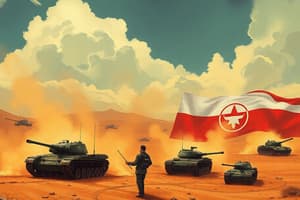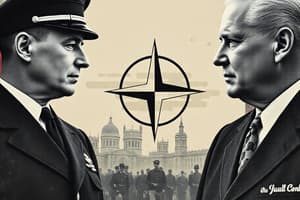Podcast
Questions and Answers
Which of the following best describes the primary goal of the Marshall Plan?
Which of the following best describes the primary goal of the Marshall Plan?
- Establishing military alliances to contain Soviet aggression.
- Promoting democratic reforms in Eastern European countries under Soviet influence.
- Facilitating the development of nuclear weapons among Western nations.
- Providing economic assistance to rebuild European economies and prevent the spread of communism. (correct)
The policy of brinkmanship is best characterized by which of the following actions?
The policy of brinkmanship is best characterized by which of the following actions?
- Providing economic aid to developing nations to foster goodwill.
- Pushing a dangerous situation to the verge of war to achieve a desired outcome. (correct)
- Engaging in diplomatic negotiations to ease tensions between superpowers.
- Maintaining a neutral stance in international conflicts to avoid escalation.
What was the significance of the Berlin Airlift (1948-1949)?
What was the significance of the Berlin Airlift (1948-1949)?
- It was a propaganda campaign that aimed to discourage East Germans from fleeing to West Berlin.
- It was a joint effort by the United States and the Soviet Union to rebuild Berlin after the war.
- It was a military operation to break through the Soviet blockade and supply West Berlin with necessities. (correct)
- It was an American mission to overthrow the communist government in East Berlin.
How did the outcome of the Chinese Civil War influence the Cold War?
How did the outcome of the Chinese Civil War influence the Cold War?
What was the primary objective of organizations such as the House Un-American Activities Committee (HUAC) during the Cold War?
What was the primary objective of organizations such as the House Un-American Activities Committee (HUAC) during the Cold War?
Which of the following statements accurately describes the concept of mutually assured destruction (MAD)?
Which of the following statements accurately describes the concept of mutually assured destruction (MAD)?
The Warsaw Pact was formed primarily in response to which of the following events?
The Warsaw Pact was formed primarily in response to which of the following events?
What was the significance of Truman's Executive Order 9835, which established the Federal Employee Loyalty Program?
What was the significance of Truman's Executive Order 9835, which established the Federal Employee Loyalty Program?
The CIA's involvement in the 1953 Iranian coup d'état was primarily motivated by which of the following factors?
The CIA's involvement in the 1953 Iranian coup d'état was primarily motivated by which of the following factors?
During the Cold War era, Radio Free Europe and Radio Liberty served primarily as instruments of:
During the Cold War era, Radio Free Europe and Radio Liberty served primarily as instruments of:
Flashcards
NATO (1949)
NATO (1949)
Alliance of Western nations based on collective defense against the USSR.
Warsaw Pact (1955)
Warsaw Pact (1955)
The USSR and Eastern Bloc's response to NATO, forming a counter-alliance.
Berlin Blockade/Airlift
Berlin Blockade/Airlift
Soviet attempt to cut off West Berlin, countered by a massive Allied airlift.
"Iron Curtain"
"Iron Curtain"
Signup and view all the flashcards
Mutual Assured Destruction (MAD)
Mutual Assured Destruction (MAD)
Signup and view all the flashcards
Arms Race
Arms Race
Signup and view all the flashcards
Containment
Containment
Signup and view all the flashcards
HUAC
HUAC
Signup and view all the flashcards
McCarthyism
McCarthyism
Signup and view all the flashcards
Marshall Plan
Marshall Plan
Signup and view all the flashcards
Study Notes
-
Study guide for U.S. History, chapters 38-40, covering the origins of the Cold War (1945-1949), its expansion (1948-1960), and fighting it at home (1945-1960).
-
Alliance of Western nations in 1949, operating under the principle of collective defense, aimed to resist the USSR and known as NATO.
-
Alliance in 1955 between the USSR and Eastern Bloc nations to counter the Western Alliance named the Warsaw Pact.
-
From June 1948 to May 1949, the Soviet Union attempted to starve West Berlin into submission, but the Allies responded with a 10+ month airlift to keep West Berlin supplied.
-
Churchill described the barrier behind which Eastern Europe was under Soviet domination.
-
Deterrence and willingness to use nuclear weapons by each nation meant that in a nuclear exchange, each nation would launch all weapons, guaranteeing devastation on both sides.
-
The Arms Race involved competition to have more powerful atomic and nuclear weapons.
-
A congressional committee sought to root out communists and communist sympathizers in the US.
-
A country fell to communism and was forced by the USSR to become a one-party state, proving to Truman that Stalin would not accept free and open elections per the Yalta agreement.
-
A country invaded by the USSR had hoped for US assistance, but the US did not provide aid.
-
In 1953, the CIA overthrew a government in Iran on behalf of the United States and Britain to ensure a favorable government with access to its oil fields.
-
The CIA overthrew a government on behalf of the United States and the United Fruit Company, which led many Latin Americans to view the US as an enemy of social reforms.
-
During a February 1945 meeting, FDR, Churchill, and Stalin decided to divide Germany into 4 zones and declared support for self-government and free elections in Eastern Europe at the Yalta Conference.
-
The FCDA was a federal program that organized people to prepare for a potential nuclear war.
-
Brinkmanship describes the government policy of willingness to go to the edge of war.
-
Intercontinental ballistic missiles (ICBMs) allowed nations to launch nuclear weapons across the globe using rockets.
-
Mao Zedong was the leader of the Communist forces in China, winning control of the mainland in 1949 and proclaiming the People's Republic of China (PRC).
-
After losing the mainland, the leader of the Nationalist forces in China fled to Taiwan and established a government-in-exile.
-
The Blacklist was a list of people thought to be communists or have communist sympathies, which meant Hollywood would not hire them.
-
During a May 1945 meeting, Truman, Attlee, and Stalin decided to divide Berlin into 4 zones at the Potsdam Conference.
-
The H-Bomb was a new fission nuclear bomb, and was much more powerful than an atomic bomb.
-
The Truman Doctrine was a policy established by Truman that required federal employees to pledge loyalty to the US.
-
The US policy was to "support free peoples who are resisting attempted subjugation by armed minorities or by outside pressures."
-
SecState Kennan's (1946) political strategy sought to contain communism within its present borders.
-
Radio was a propaganda method used by the United States to encourage resistance and inform people living under communist control.
-
McCarthyism reckless persecuted innocent people, usually without any evidence; used by a senator from Wisconsin.
-
A recovery plan of economic aid was available to all European nations to help rebuild their economies, as long as the money was spent on goods made in the US.
-
The Soviet Union created a program to develop two-way trade agreements between itself and other Eastern Bloc nations as a response to the Marshall Plan.
-
Under communism, working-class people would deserve a fair share of the nation's wealth.
Studying That Suits You
Use AI to generate personalized quizzes and flashcards to suit your learning preferences.



